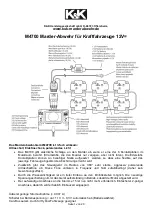
Ignition System
WARNING
To avoid personal injury and/or vehicle damage, refer to the service precautions at the
beginning of this section.
General Information
NOTE:
For information on understanding electricity and troubleshooting electrical circuits,
please refer to chassis electrical.
Coil on Plug (COP) System
The coil over plug system was developed so that spark and spark timing could be better
controlled on an individual cylinder basis. Each cylinder has an ignition coil mounted
directly above the spark plug on the cylinder head cover. A short suppresser/connector
replaces the spark plug wire and links the coil to the plug. There are different methods
used for primary triggering. Some manufacturers use a combination coil/module, which
means each coil has its own control circuit that is activated by the PCM. Others use
remote mounted modules to trigger the coils.
Each individual coil is allowed to saturate while all other cylinders fire. For a V-8 engine,
this allows a period of seven firing events for coil saturation, compared to three events for
the same V-8 engine with a waste spark system. The coil over plug system also benefits
from a minimum amount of energy lost, due to the resistance of spark plug wires.
Magnetic Sensor / Pick-Up Coil
The magnetic sensor in electronic ignition system is made up of a small coil of wire
wrapped around an iron core, a permanent magnet and a toothed wheel called a reluctor.
These sensors can be found mounted in a distributor, or at the front, middle, or rear of the
crankshaft or camshaft, and are two-wire sensors.
The permanent magnet produces a magnetic field that passes thru the center of the pick-
up coil. As the reluctor turns, the small teeth enter the magnetic field. Because the metal is
a better conductor for the field than the air between the magnet and reluctor, the field
strength begins to increase and reaches its maximum when the reluctor teeth are closest
to the sensor. An increase in magnetic field induces a positive voltage to the module. As
the teeth leave the magnetic field, the decrease in pole strength induces a negative
voltage into the module. This alternating positive and negative voltage causes a small AC
current. This alternating current after passing through an analog/digital converter is used
by the module or engine controller to trigger the primary circuit.
Summary of Contents for TrailBlazer
Page 1: ......
Page 26: ...Fig 3 Typical body and undervehicle maintenance locations Refer to chart for descriptions ...
Page 29: ......
Page 30: ......
Page 31: ......
Page 175: ...Spring free length check Valve spring squareness check ...
Page 192: ...Front of piston mark ...
Page 361: ...5 3L Engine Except Saab Underhood Fuse Block 2003 2005 Early Production ...
Page 469: ...Removing the outer band from the CV boot Removing the inner band from the CV boot ...
Page 470: ...Removing the CV boot from the joint housing Clean the CV joint housing prior to removing boot ...
Page 471: ...Removing the CV joint housing assembly Removing the CV joint ...
Page 472: ...Inspecting the CV joint housing Removing the CV joint outer snap ring ...
Page 473: ...Checking the CV joint snap ring for wear CV joint snap ring typical ...
Page 474: ...Removing the CV joint assembly Removing the CV joint inner snap ring ...
Page 475: ...Installing the CV joint assembly typical ...
Page 553: ...9 Torque the lug nuts to specification 10 Lower the vehicle ...
Page 556: ...Toe in Frame Misalignment Frame misalignment ...
Page 588: ...Bleeding caliper ...
Page 624: ...Manifold gauge set components Refrigerant recovery recycling station ...
Page 676: ...A C Specifications ...
Page 677: ......
















































